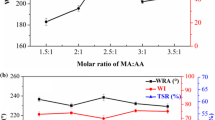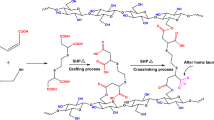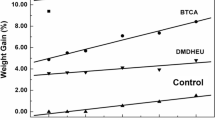Abstract
1,2,3,4-Butanetetracarboxylic acid (BTCA) can cause significant strength loss to cotton fabrics, but it has been proven that a flexible molecular structure could benefit the strength in our previous study. In this research, more flexible copolymers [P(IA–AA)] were synthesized with itaconic acid (IA) and acrylic acid (AA) and creatively used as a formaldehyde-free crosslinking reagent for cotton fabrics to replace BTCA. The optimal synthetic conditions of P(IA–AA) were recommended as that the molar ratio of IA:AA and reaction time were 1:1 and 3 h, respectively. The structure of P(IA–AA) was characterized with proton nuclear magnetic resonance spectroscopy, mass spectroscopy and Fourier transform infrared spectroscopy. Results provided evidence that the P(IA–AA) was synthesized with two IA and two AA molecules (molecular weight was 406). Through careful selection, the optimal anti-wrinkle finishing conditions were P(IA–AA) concentration of 160 g/L, pH value of 2.1, curing temperature of 180 °C, and curing time of 2 min. By comparing with IA, BTCA, citric acid (CA), and copolymers of maleic acid (MA) and AA [P(MA–AA)] in the similar conditions, the P(IA–AA)-treated fabrics showed the highest tearing strength retention of 59.30% and whiteness index of 77.60, and the wrinkle recovery angle of the P(IA–AA)-treated fabrics (245.1° ± 0.85°) was comparable with that of the CA-treated ones (244.7° ± 4.30°). Additionally, by separating the strength loss caused by degradation (TSLD) from that caused by crosslinking (TSLC), the P(IA–AA)-treated fabrics presented about 10% less TSLD than P(MA–AA)-treated ones with a comparable TSLC.







Similar content being viewed by others
References
Bajaj P, Paliwal DK, Gupta AK (1993) Acrylonitrile-acrylic acids copolymers. 1. Synthesis and characterization. J Appl Polym Sci 49:823–833
Chen D, Yang CQ, Qiu X (2005) Aqueous polymerization of maleic acid and cross-linking of cotton cellulose by poly(maleic acid). Ind Eng Chem Res 44:7921–7927
Harifi T, Montazer M (2012) Past, present and future prospects of cotton cross-linking: new insight into nano particles. Carbohydr Polym 88:1125–1140
Hu H, Dong X, Tang W, Yao J, He J (2018) Effects of molecular structures of poly-carboxylic acids on crosslinking reaction. Dye Finis 01:0001–0005
Ji B, Tang P, Yan K, Sun G (2015) Catalytic actions of alkaline salts in reactions between 1,2,3,4-butanetetracarboxylic acid and cellulose: II. Esterification. Carbohydr Polym 132:228–236
Ji B, Qi H, Yan K, Sun G (2016a) Catalytic actions of alkaline salts in reactions between 1,2,3,4-butanetetracarboxylic acid and cellulose: I. Anhydride formation. Cellulose 23:259–267
Ji B, Yan K, Sun G (2016b) Investigation on functional properties of 1,2,3,4-butanetetracarboxylic acid cross-linked fabrics impacted by molecular structures and chemical affinity of catalysts. Ind Eng Chem Res 55:5216–5222
Ji B, Zhao C, Yan K, Sun G (2016c) Effects of acid diffusibility and affinity to cellulose on strength loss of polycarboxylic acid crosslinked fabrics. Carbohydr Polym 144:282–288
Ji B, Zhao C, Yan K, Sun G (2018) Effects of divalent anionic catalysts on cross-linking of cellulose with 1,2,3,4-butanetetracarboxylic acid. Carbohydr Polym 181:292–299
Ji B, Tang P, Hu C, Yan K (2019) Catalytic and ionic cross-linking actions of L-glutamate salt for the modification of cellulose by 1,2,3,4-butanetetracarboxylic acid. Carbohydr Polym 207:288–296
Liang T, Yan K, Zhao T, Ji B (2020) Synthesis of a low-molecular-weight copolymer by maleic acid and acrylic acid and its application for the functional modification of cellulose. Cellulose 27:5665–5675
Luo M, Li H, Huang C, Zhang H, Xiong L, Chen X, Chen X (2018) Cellulose-based absorbent production from bacterial cellulose and acrylic acid: synthesis and performance. Polymers 10:702–719
Peng H, Yang CQ, Wang X, Wang S (2012) The combination of itaconic acid and sodium hypophosphite as a new cross-linking system for cotton. Ind Eng Chem Res 51:11301–11311
Qi H (2017) Formaldehyde-free anti-wrinkle finishing on cotton fabrics by polycarboxylic acids. Donghua University, Shanghai
Qi H, Huang Y, Sun G, Qing F, Yan K (2016a) Anti-crease finishing of cotton fabrics based on crosslinking of cellulose with acryloyl malic acid. Carbohydr Polym 135:86–93
Qi H, Pan J, Qing F, Yan K, Sun G (2016b) Anti-wrinkle and UV protective performance of cotton fabrics finished with 5-(carbonyloxy succinic)-benzene-1,2,4-tricarboxylic acid. Carbohydr Polym 154:313–319
Schramm C, Rinderer B, Tessadri B (2014) Non-formaldehyde, crease resistant agent for cotton fabrics based on an organic–inorganic hybrid material. Carbohydr Polym 105:81–89
Tang P, Ji B, Sun G (2016) Whiteness improvement of citric acid crosslinked cotton fabrics: H2O2 bleaching under alkaline condition. Carbohydr Polym 147:139–145
Vadakkekara GJ, Thomas S, Nair CPR (2020) Sodium itaconate grafted nanocellulose for facile elimination of lead ion from water. Cellulose 27:3233–3248
Wan Y (2014) Synthesis and properties of low molecular weight poly(acrylic acid-co-itaconic acid). Zhengzhou University, Zhengzhou
Yang CQ (1991) FT-IR spectroscopy study of the ester crosslinking mechanism of cotton cellulose. Text Res J 61:433–440
Yang CQ, Gu X (2001) Polymerization of maleic acid and itaconic acid studied by FT-Raman spectroscopy. J Appl Polym Sci 81:223–228
Yang CQ, Wang X (1996) Formation of cyclic anhydride intermediates and esterification of cotton cellulose by multifunctional carboxylic acids: an infrared spectroscopy study. Text Res J 66:595–603
Yang C, Wang X, Kang I (1997) Ester crosslinking of cotton fabric by polymeric carboxylic acids and citric acid. Text Res J 67:334–342
Yang CQ, Xu L, Li S, Jiang Y (1998) Nonformaldehyde durable press finishing of cotton fabrics by combining citric acid with polymers of maleic acid. Text Res J 68:457–464
Yang CQ, Hu C, Lickfield GC (2003) Crosslinking cotton with poly(itaconic acid) and in situ polymerization of itaconic acid: fabric mechanical strength retention. J Appl Polym Sci 87:2023–2030
Acknowledgments
This research was funded by the National Natural Science Foundation of China (51803025), the Fundamental Research Funds for the Central Universities (2232020D-21), and the China Postdoctoral Science Foundation Project (2018M641893).
Author information
Authors and Affiliations
Corresponding author
Ethics declarations
Conflict of interest
The authors declare that they have no conflict of interest.
Additional information
Publisher's Note
Springer Nature remains neutral with regard to jurisdictional claims in published maps and institutional affiliations.
Rights and permissions
About this article
Cite this article
Liang, T., Yan, K., Zhao, T. et al. High strength retention of cellulose fibers crosslinking with synthesized low-molecular-weight copolymers of itaconic acid and acrylic acid. Cellulose 28, 1167–1178 (2021). https://doi.org/10.1007/s10570-020-03574-z
Received:
Accepted:
Published:
Issue Date:
DOI: https://doi.org/10.1007/s10570-020-03574-z




